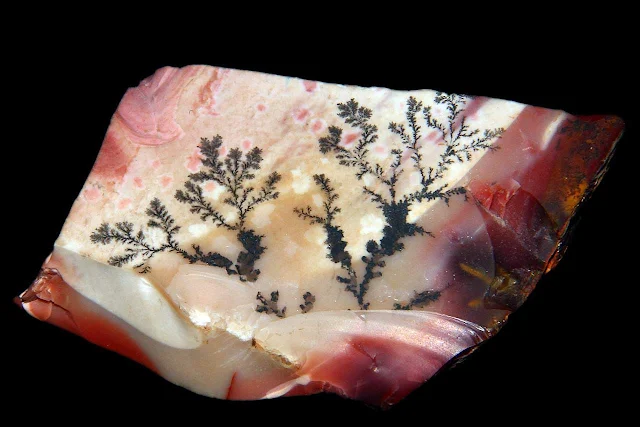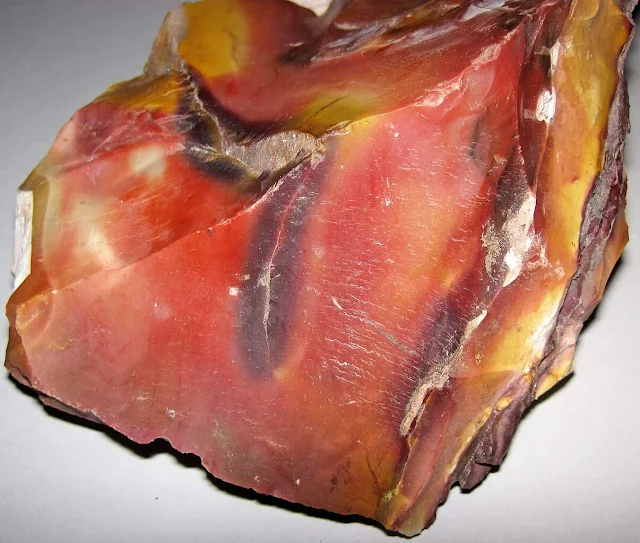Mookaite Jasper: Gemstone, Properties, Uses
Mookaite Jasper is a visually stunning gemstone characterized by its opaque appearance, distinct patterns, and a broad color spectrum that includes reds, yellows, oranges, purples, pinks, and creams. It is sourced exclusively from the Kennedy Ranges near Mooka Creek in Western Australia, the geographical feature from which its name is derived. Alternative names for this material include Mookite, Mook Jasper, and Australian Jasper.
Despite being commonly marketed and referred to as a "jasper" due to its visual characteristics and silica-based composition, Mookaite possesses a distinct geological classification. It is not technically a true jasper. The fundamental difference relates to its formation process:
- True Jasper: Consists primarily of microcrystalline quartz (chalcedony) with coloration resulting from various mineral inclusions, such as iron oxides.
- Mookaite Jasper: Consists primarily of radiolarian chert. This is a siliceous sedimentary rock formed from the lithified, silica-rich skeletal remains of microscopic marine organisms known as radiolaria.
Consequently, while Mookaite shares visual similarities with jasper and is often categorized with it in lapidary and commercial contexts, geologists more accurately classify it as a form of chert. Its origin as fossilized radiolaria is the primary factor contributing to its characteristic appearance.
Mookaite Jasper Formation
Mookaite jasper formed around Cretaceous Period -145 million years ago- from the fossilized remains of tiny sea creatures called radiolaria. These creatures' silica skeletons compressed and hardened over time, creating the beautiful jasper we see today.
Formation Process
- Microscopic marine creatures called Radiolaria lived in shallow seas in Western Australia. These tiny protozoans had silica shells that accumulated on the seabed as sediment over millions of years.
- As sea levels receded, the sediment layers were compressed and hardened by overlying rock. This process, called lithification, transformed the loose sediment into solid rock.
- As sea levels receded, the sediment layers were compressed and hardened by overlying rock. This process, called lithification, transformed the loose sediment into solid rock.
- Groundwater rich in silica and other minerals, such as iron and manganese, seeped through the rock layers. These minerals interacted with the silica in the sediment, creating the vibrant colors and patterns that characterize Mookaite Jasper.
- Eventually, geological processes like erosion brought the Mookaite Jasper to the Earth's surface in the Kennedy Ranges of Western Australia.
Mookaite Jasper Composition
Primary Constituent: Fossilized radiolarian chert, predominantly composed of microcrystalline quartz (chalcedony). These fossilized radiolarian tests (skeletons) give Mookaite Jasper its unique texture and contribute to its hardness and durability.
Secondary Components: Varying amounts of opal, limonite, hematite, and other minerals can be present, influencing the stone's vibrant colors and patterns. Limonite contributes to the red and yellow hues, while hematite adds reddish-brown and purple tones. Opal's presence can create play-of-color effects in some specimens.
 |
| Jasper Mookait with dendrites. Photo: Lech Darski |
Mookaite Jasper Properties
Hardness: Mookaite Jasper measures between 6.5 and 7 on the Mohs scale of mineral hardness.
Color: Mookaite Jasper boasts a vibrant palette, showcasing a remarkable diversity of hues. Red, yellow, brown, purple, and white often intermingle in captivating swirls and patterns, arising from the varied mineral inclusions and their distribution within the stone.
Luster: The luster of Mookaite Jasper varies depending on its composition and surface texture. Typically, it exhibits a vitreous (glass-like) luster, reflecting light brightly due to its smooth surfaces and well-developed microcrystalline structure. However, some specimens possess a more subdued waxy luster, attributed to the presence of chalcedony and minor surface irregularities.
Transparency: Mookaite Jasper is generally opaque, meaning light cannot penetrate its interior. This opacity results from the scattering of light by the dense array of microcrystalline silica and mineral inclusions within the stone.
Fracture: When subjected to stress, Mookaite Jasper tends to fracture along a conchoidal pattern.
Specific Gravity: Mookaite Jasper exhibits a specific gravity ranging from 2.57 to 2.64 grams per cubic centimeter (g/cm³).
Cleavage: Unlike some minerals that split along defined planes, Mookaite Jasper lacks cleavage.
Streak: Crushing it reveals a white, yellow, or reddish streak, depending on its mineral inclusions.
Density: As mentioned earlier, Mookaite Jasper's density ranges from 2.57 to 2.64 g/cm³, indicating a tightly packed internal structure.
Polishability: Mookaite Jasper readily accepts polishing, allowing its inherent beauty to shine through.
Metaphysical Properties
While scientific research hasn't validated the metaphysical properties attributed to mookaite jasper, it's important to acknowledge their significance in cultural and spiritual practices. Some commonly associated properties include:
- Grounding and stability: Mookaite jasper is believed to connect one to the Earth, promoting a sense of grounding and stability.
- Emotional healing: It's thought to soothe emotional stress and anxiety, bringing peace and a sense of wholeness.
- Decision making: Mookaite jasper may offer clarity and guidance when faced with difficult choices, encouraging adaptability and acceptance of change.
- Creativity and adventure: It's believed to spark creativity and inspire a sense of adventure, promoting new experiences and personal growth.
Remember, these metaphysical properties are based on traditional beliefs and practices, not scientific evidence. However, understanding them can provide a deeper appreciation for the cultural significance of mookaite jasper.
Where is Mookaite Jasper found
Mookaite Jasper is exclusively found in the Kennedy Ranges of Western Australia, near a stream called Mooka Creek. This is where the majority of commercially available Mookaite Jasper originates.
Mookaite Jasper Uses
Mookaite Jasper boasts a diverse range of uses, captivating not only with its beauty but also with its versatility.
Jewelry: Mookaite Jasper is frequently used to create stunning jewelry pieces like necklaces, bracelets, earrings, and rings. Its vibrant colors and patterns make it a unique and eye-catching material for personal adornment.
Cabochons and carvings: Polished Mookaite Jasper cabochons can be used for decorative purposes, incorporated into mosaics, or mounted as standalone art pieces. Additionally, skilled artisans carve the stone into figurines, bowls, and other intricate objects.
Home Décor: Mookaite Jasper's natural beauty makes it a perfect addition to home décor. Polished slabs can be used as coasters, tabletops, or even wall hangings. Its grounding energy is also appreciated by those who incorporate it into feng shui practices.
Scientific Study: Due to its unique geological formation and composition, Mookaite Jasper holds interest for geologists and other scientific researchers. Studying its formation can offer insights into ancient marine environments and fossil preservation processes.





%20(1).webp)






